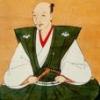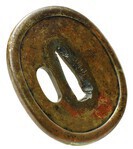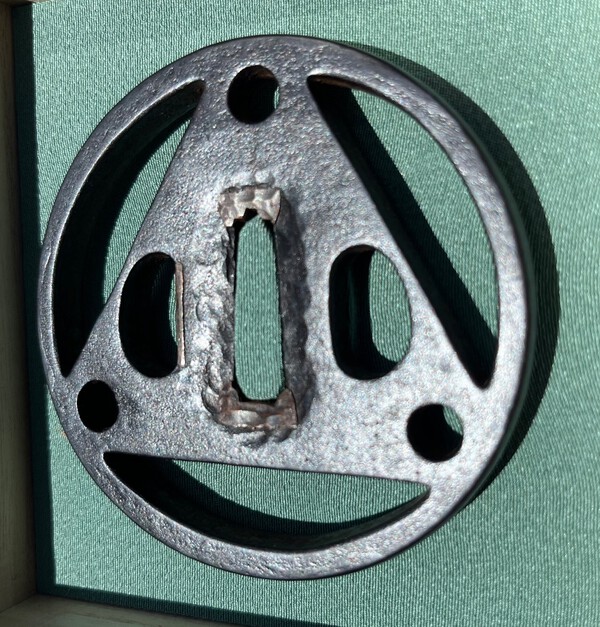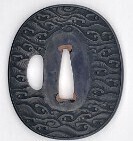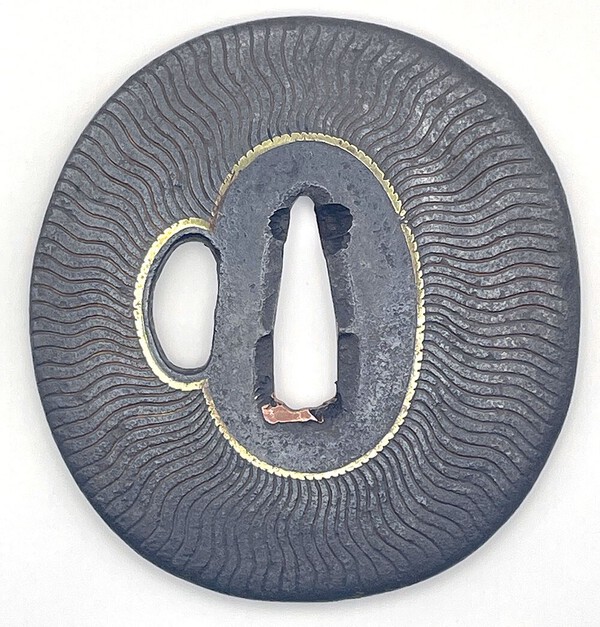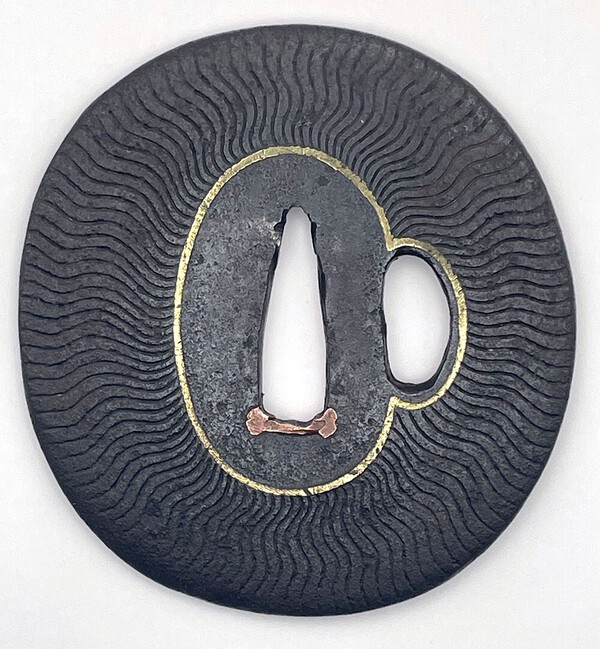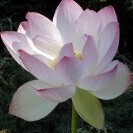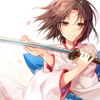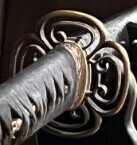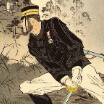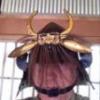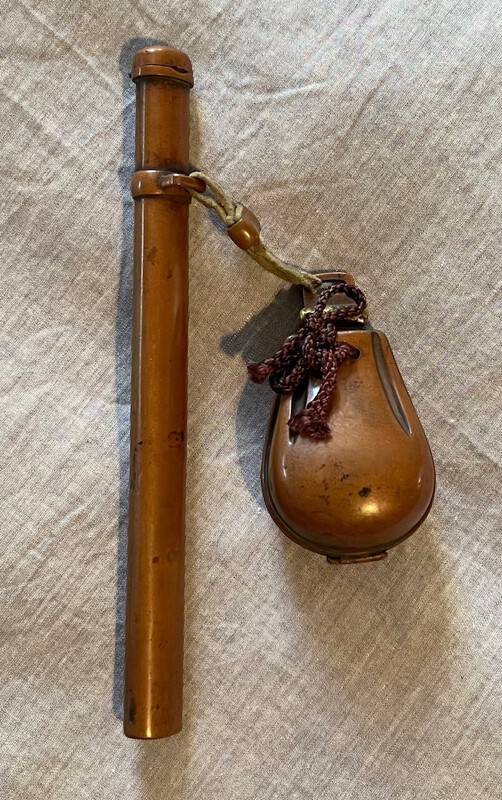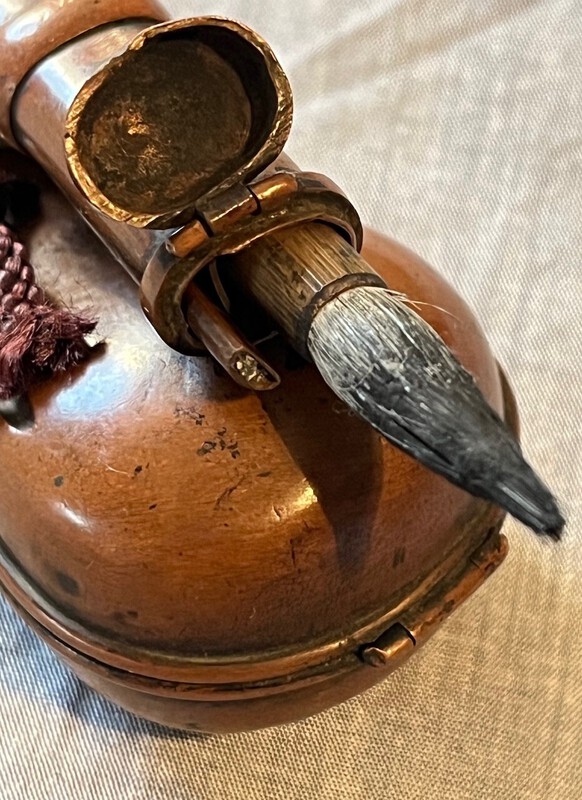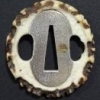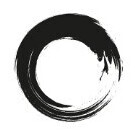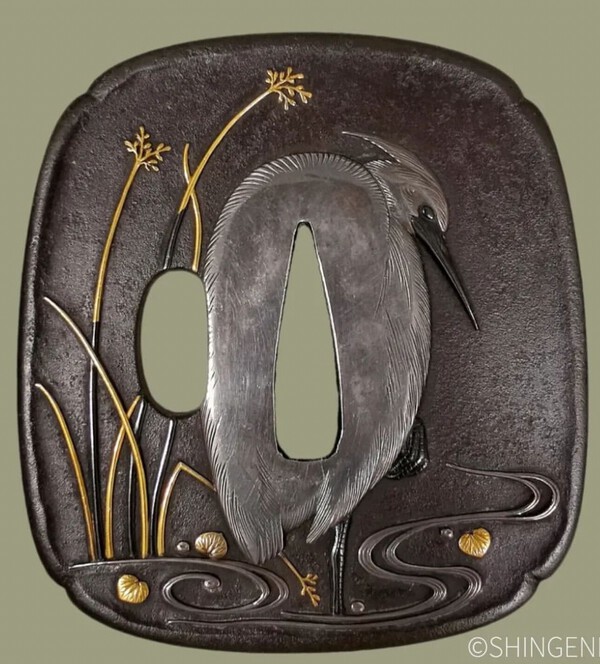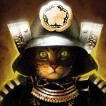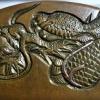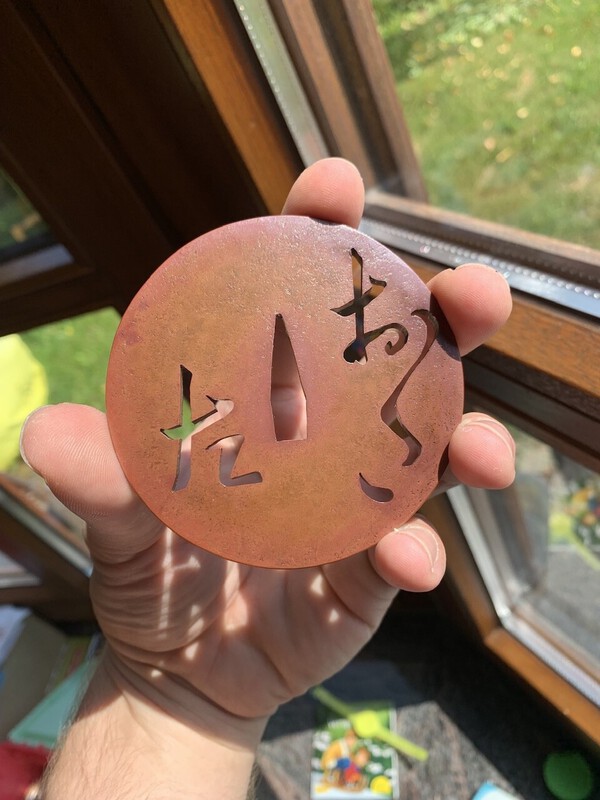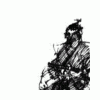Leaderboard
Popular Content
Showing content with the highest reputation on 08/19/2024 in all areas
-
Remembering Ford's demonstration in the Citadelle de Besançon 2014, just 10 years ago: I had the pleasure to exchange a few e-mails with him over the years. We also communicated on some material I sent him like old wrought iron and raw copper (from an experimental production process) for his work. I will miss him greatly.7 points
-
The one on the left; 備前國長舩秀光 – Bizen no kuni Osafune Hidemitsu 生茎而備州長ノ三字判讀サル小反物ノ特色ヲ明示スル所作而取分ケ互乃目ヲ揃ヘテ焼ク點ガ同工ニ擬セラレ候 - Unshortened nakago, and three characters “備州長” are deciphered. The characteristics of Kozori school can be seen. Especially its regular gumone suggests the smith’s work. 長貮尺壹寸有之 – Length is 2-shaku 1-sun. 惟時癸巳極月探山邉道識 – Mizunoto-Mi (2013), December, Tanzan Hendo appraised.5 points
-
I call it finished, here the video that shows it much better Now some engraving after I haven’t even signed the last piece Katakiribori a Yokoya motif. Some flaws and many things that could be done better but I won’t get better not doing it. Love the horses eye, after looking at Somin pieces it was cool to see that he does not used a punch like many later artist did but chisel around the pupil so I also tried it. I’m happy with the result but this was actually the easier side of the Tsuba.4 points
-
You may want to post a higher-resolution image for Tanobe sensei's sayagaki. The one on the right reads: 菊紋 = kikumon 太刀銘 = tachi mei 金剛日向守盛久 = Kongō Hyūga no Kami Morihisa 天明六八月日 = on a day in the eighth month of Tenmei 6 (1786 CE) 刃長 壱尺九寸壱分半有之= length: 1 shaku 9 sun 1.5 bu (~58.02 cm)3 points
-
I read there are theories about the nature and the mundane themes (like everyday items) being about remembering life and beauty, in contrast to the violent episodes of warriors' lives. As it is, unless someone has some written document or journal that states why some design choice was made, we won't know if it's simply esthetics, religious or philosophical belief, or to invoke protection/strength, etc. Perhaps people who have seriously designed tsuba can weigh in, but I do like the look and texture of the halo (amida yasuri) over relatively rough iron, so in my case, it's less about meaning and more about visual effects.3 points
-
Hey guys, Apologies getting back to you all, especially in view of the great feedback. Unfortunately I've been without a working computer for the last week, but back up and running now! Thanks everyone who's answered the questionnaire. Been a massive help. Thanks for the photos a couple of you sent of the Berlin museum. I haven't had the chance to go there before and it looks like they're doing a lot of the kinds of things that would be valuable in Japan. Now for a block of text, but just want to address a few of the points that have come up in several people's comments and give you guys a little insight into the inner workings of museums. 1. Multi-lingual info: This is a massive one. I'm very sad to hear that the Nagoya museum isn't up to snuff, especially in view of the amount of money put into it. And I agree totally that even the bigger national museums could really improve what they're offering. As for our museum, here's what we currently have/ are working on re: multi-lingual info. a. The Japanese info panels that we have are fairly detailed for each individual sword, giving appraisal notes and historical details of the smith/blade. Because of this, when we tried to put the English info in physical form within the cases, they took up too much room and became rather cluttered. At the mo, I've been putting all the English caption info online, accessible through a QR code in the exhibition room. Not 100% ideal, but at least it also allows for auto-translation into languages other than English. We've also got a couple of folders with print-outs which people can carry around with them as they go through the exhibitions. b. I definitely agree with the utility of a museum app. While I doubt I will be able to secure funding for a fully custom-made app like those at the museums mentioned, I am trying to get some kind of audio-guide made so that people can listen as they look, likely using an off-the-shelf, free utility like Izi Travel or SmartGuide. If any forumites have experience with audio-guides or museum app production and have advice, I would absolutely love to hear it! c. If anyone has any inventive/low-cost solutions that they've seen in other places, absolutely all-ears. 2. Technology: This too is a real sticking point. As you might imagine, a countryside museum like ours doesn't have the largest budget, so I've been struggling to get anything technology-related funded. Something like those screens in the Berlin museum I feel would be ideal, as they would allow people to switch between multi-lingual captions, but alas. An interesting point that some of you may not have seen is that even the national museums are struggling. It was covered in the news quite widely here last year but, for example, the Tokyo National Museum had a several-million dollar shortfall in their budget last year because their electricity bill had gone up massively. As you will all probably know, swords have to be kept at a cool 21 degrees celsius and <45% RH, which can lead to just the climate control in summer costing upwards of 100K for even a smaller museum like us. 3. Purchasing policies: Following on from the last point, Michael.S is absolutely correct re: funding issues. We have been able to get a bit of money from central government to improve our museum's permanent introductory area, but for regular exhibitions, the funding is fairly limited. Another thing is that any museums run by local government are rather hamstrung by their purchasing policies. Basically, if a company is not local, the city office and museums can't buy anything from them (supposedly to support local businesses). This may not be a problem in large cities, but for us, that means spending huge amounts for even the basics, due to economies of scale. Honestly, this is one of my biggest bugbears and a major cause of contention. 4. Lighting: This, I think, we do pretty well, though I suppose comes from being set up specifically to look at swords. When we set up an exhibition, we adjust the angle and bulb-type of every single light fitting to best show off each individual blade (e.g. switching between LED and halogen to better show off hada or hamon). Unfortunately, new laws are coming in that require that use of LEDs across the board in museums, so we will be slightly limited in that respect potentially going forward. We regularly discuss with local polishers to get advice on lighting too, so we are definitely attempting to improve in this area. Unfortunately, despite the high-quality of the collections in the TNM, not all rooms are set up for sword displays, so I must agree that when I went to see their National Treasure exhibition last year, the swords were not in their usual room, and so the lighting left a lot to be desired. That said, their sword curator (Sato san) is top-class, so it's definitely more an issue with the facility, and not the staff, and the main sword gallery is well-lit. 5. Monoculars: We actually lend these to customers for free if they ask, so be sure to check with us for one if you ever visit (ask for a 'tangankyo'). 6. National Treasure displays: This may be new info for some, so out of interest I thought I'd mention it! All Municipally/Prefecturally/Nationally-Designated Important Cultural Properties (including National Treasures) can only be displayed for a max of 60 days/ year by law to aid in preservation. While this is the legal max, many objects are displayed for much less time, due to their condition. For instance, the Sanchomo's koshirae is in a delicate state, so we generally limit it to 10 days/ year. 7. More info on the web: Thanks for the recommendation Jussi. I'll see what I can do. While I don't think a fully searchable collections database (a la British Museum, MET, etc.) will be possible, mostly due to the limitations of our website CMS, I will try to make sure that at least the translated English exhibition index is uploaded for each new exhibition from now on. Fun fact, it was touch-and-go as to whether we would be able to display the onaginata due to its size. Luckily, there is exactly one spot where we can actually get it into the case. 7. Sensible exhibition orders and expositive info: This too is something I think we are doing reasonably well, though I do think that, if anything, we actually have too much explanatory info and could do with reducing the amount. Even so, while we do generally also put items in time order (simply because we want to go out on a 'bang' and the best stuff tends to be oldest), we make sure to have info for each item and thematic info given after every 2-3 blades. 7. Curatorial eccentricities: Another bit of info that people might be interested in and may explain some of the problems people have seen at museums. As some have already surmised, many museums don't actually have a specialist sword curator, which explains the poor lighting in a lot of places. However, even where there is one, each tends to have a very specific way of doing things. For instance, despite most museums displaying tachi curve down, and katana curve up, I believe it was the curator at the Kyoto National Museum who does everything curve up, as he's worried about chipping the edge if it's edge down. In our case, the curator was originally a researcher/writer, so we tend to be very heavy on caption info, with less effort placed into graphics/broader considerations around visitor knowledge-levels etc. None of these ways of doing things is necessarily correct or incorrect, but they are reflected in the exhibitions. Lewis B, unfortunately no special exhibition in May 2025, but in fact it is likely that that will be when we are hosting the first exhibition that I will be in charge of, likely themed on comparisons between Japanese swords and those from other countries. If you happen to visit, give me a shout! For those interested in seeing captions for our current exhibition, don't currently have a link, but will grab that tomorrow and post here so people can see what they're like (I will say in advance, many apologies for the rough formatting, again, the CMS is not great).3 points
-
FYI - I have decided to release updated versions of the Stamps document on an annual basis, rather than semi-annually. New discoveries have slowed. There are a few since the Mar '24 version, but not enough to warrant a new release. Thanks to all who have contributed!2 points
-
Both of these have been presented before, and both are regarded as added later to increase interest iirc. Unconvincingly done, and the second one doesn't have a convincing aesthetic. They also don't match the schools of the tsuba. Most verified Christian tsuba (and there are very, very few of them) are done very discreetly.2 points
-
I think it would depend in part upon where and when the tsuba was crafted. Christianity was definitely *present* in medieval Japan at different intervals and in different provinces, particularly in Northern Kyushu or in the Sendai region under the Otomo and Date clans respectively.2 points
-
My guess: 相州住貞宗作 Sōshū-jū Sadamune saku Made by Sadamune of Sōshū (Not really made by Sadamune, mind you. Just an homage-type inscription).2 points
-
I'm a fan of what Steve proposes regarding an Ohno Consensus Working Group, (and, perhaps, not only for Ohno). In particular, the inductive approach Steve describes is one I have highly endorsed and subscribed to for years (as many will know). This much more systematic and objectively analytical method isn't sufficiently present in tosogu scholarship, in my experience. Instead, there is too much reliance on uncritically accepting "what Sensei said," both in Japan and in the West. Clearly, there can be value in "Sensei's" teachings, even a lot of value; the trick is to discern what is valid and valuable, on the one hand, and what, on the other hand, is based on "traditional understandings" which had as their basis questionable "knowledge" followed by a steady and stubborn subscribing to an Emperor's-New-Clothes narrative. Navigating these murky waters is tricky, of course. But that's why what Steve proposes here is so inviting: anchoring an approach to tsuba scholarship in the material details of what can be seen in the objects themselves, and then, when a sort of "critical mass" of generalization can be realized, moving relatively organically to a more deductive approach by which theories and understandings can be tested. In the end, we still may not arrive at any absolutely hard and fast conclusions, but given the current instability present in assigning "Ohno membership" to a variety of disparate tsuba, it seems to me Steve's proposal has merit and certainly worth pursuing.2 points
-
2 points
-
Well Jesse, I will simply buy it and then we will know the exact price and what it is!2 points
-
Close to Hirata Hikozo Actually this would be perfect but I’m not convinced in investing so much because I’m mainly interested in seeing the workmanship of the Odawara Fukurin and the circular „file marks“. I would want to sell it afterwards without much lost money if possible and can compromise a lot of condition if some parts are still good. So I want to own them to study it in depth and then get to the next piece somehow. Thanks for your efforts and the 2nd piece is also interesting but I’m not sure yet. Edit: without the odawara Fukurin I won’t be happy, it is definetly a nice looking piece with a beautiful shape and surface but from the pictures the rim appears much thicker then an Odawara Fukurin. Im also not in a hurry and like to see what comes up. There also was a nice yokoya Somin Kozuka at Touken komachi for around 15k€ that is now already sold but I would prefer a Tsuba honestly. Saved the pictures on my computer because interestingly there is a much cheaper Kozuka with the same motif from another artist that clearly shows where the price difference comes from imo. EDIT 2: Its boring without the pictures but i wonder why they have the pictures of the Somin in a much lower resolution.2 points
-
I recently picked this one up. It appears to be a stylised representation of the halo of the Amida Buddha. I am curious about the theme… Was this a common theme? Was it like the European knights having Christian imagery worked into their swords and armour as protective symbols? Given the wide variety of imagery from nature, legend, folklore, history etc on tsuba were there areas that specialised in religious themes? (This is connected to the current discussion started by iado dude on another thread)1 point
-
Hello everybody, Here some (bad pictures) I took at Nijojo Castel. I suggest a little challenge finding Who is Who from the top 1 to the bottom 6, I'll put futher picture to help finishing with nakago... You will have to find which one is masamume, muramasa, nagazone kotetsu, Ikkansai Shigetsugu, and a last mystery one you have to find (extra point). Maybe easy for some, maybe educational or fun for others. I will give the rate of correct by MP, as many trys as you like. Hope you'll enjoy...1 point
-
1 point
-
Hello sir. Yesterday I was doing the annual re-oiling and inspection of my blades. I had a thought about a cut on one of the Saya, quite deep and clean. It reminds me a lot of the cut on the saya of the "Izumi no Kami Kanesada". Placed exactly in the same place by coincidence. I was wondering if you often encounter this type of mark on Koshirae? If it was rather common or not.1 point
-
Further comment, "The sword confirms the signature and not the other way around," a phrase the late Arnold Frenzel often used at our RSG meetings. Which leaves something to think about here. This mei may indeed be a false signature as Kirill opines. Despite that, we don't know what this sword really is right now other than an unpolished Japanese sword with a Kanesada mei. It could still be a "Kanesada" sword. This could simply be an added signature onto a "Kanesada" sword, which doesn't change the fact that it's a false signature, if so. And we wouldn't know which Kanesada either? The reason I bring this up is that when we analyze swords, we need to take into account everything that is going on especially the business end of the sword. Think about this way. What if you had an important sword with a false mei, an added mei? It wouldn't be the first time after a false mei was removed that a sword was then attributed to the same name, as Jim Kurrash might've pointed out. Food for thought ... p.s. It's never easy.1 point
-
Fyi, https://www.militaria.co.za/nmb/topic/13261-beautiful-christian-tsuba/1 point
-
54. I've been into collecting militaria since I was a kid. Fascinated with Japanese blades ever since seeing the original "Shogun" series on TV back in the early 1980's. (Plus all the old WW2 documentaries I watched growing up) But I never considered getting into collecting actual Nihonto until about 7 years ago, when I picked up my first WW2-era Gendaito as part of an unexpected local buy. Nowadays, it's the primary focus of my collecting.1 point
-
I think it’s just that the results of shinsa are not always right. They have a tough job trying to fit all tsuba into “schools,” which is not suited for some tsuba with features of multiple categories. And then they can just be plain wrong.1 point
-
While I do not know the fine inner workings of NBTHK, I would not think specifics of hi in general would stop swords. There are actual cases where the sword has been altered between Jūyō and Tokubetsu Jūyō shinsa and the sword has passed Tokubetsu Jūyō. Of course for that specific sword it might have been that something particular on that hi threw off the judging panel. NBTHK sometimes seems to be flexible on their standards and sometimes very strict. For examples some saiha (rehardened) blades have passed Jūyō. Latest example that is have good info on is the named sword Hachiman Masamune 八幡正宗 in session 68. However the sword has huge background info and provenance. That historical provenance is something I am just now starting to get into and it is super fascinating. I actually spent 14 hours last weekend researching background of some shrine & museum swords. The famous Kōsetsu Samonji has been in Japanese experts opinion shortened c. 10 cm from original length. It is very famous sword I just checked I have it featured in 24 different reference books/magazines. I believe the Catawiki sword would be in original length. To me it looks like the tachi mei it had has been removed. NBTHK passed it as Kōdai Hōju - Later Hōju (後代宝寿). While Hōju can be seen as Kamakura - Nanbokuchō work, when NBTHK puts 後代宝寿 in brackets they put it towards Muromachi period work. So it would most likely not be the Kamakura period sword that was advertised. Still I am bit puzzled why NBTHK did not pass it as mumei tachi but went for mumei katana.1 point
-
1 point
-
1 point
-
Bradley, thank you very much for sharing. It looks Beautiful MikeR1 point
-
Religious symbolism played a very great part in the bushi world. Christianity flourished briefly after the first missionaries arrived but was soon heavily proscribed, generally becoming 'discrete' as said above. Exceptions noted. (I have had quite a few tsuba over the years which could be interpreted as Christian, for varying reasons.) But this question has been argued hotly and repeatedly here on this forum.1 point
-
1 point
-
1 point
-
1 point
-
Feeling its Soul? As the late lamented Actor Richard Harris would say... "Ah..... Soul!"1 point
-
Thanks. I have seen wheels, halos, and possible Jesuit influences (tokei tsuba), but wondering how much this was a thing, and whether it was for design aesthetics or as some form of protective charm… On a side note: The comparison was strictly limited to people who wear armour and use swords… Christian symbols were often incorporated into these items, so I am interested in whether this was similar in Japan. FWIW: As far as I can tell the whole chivalric idea is pretty much bullshit retrospectively applied, in much the same way that Bushido was…1 point
-
Ono is one of the hardest, because different scholars have sliced and diced in different ways over the years. Even Torigoye+Haynes said there were "two different types of Ono" with the subtext of Really Good Ones, and not so good ones that got put there because scholars didn't know where else to place them in the Owari area pantheon. I also had a well recognized Temple Bell 'Kanayama' (Nihon to Koza) that was both thin, small, yakite, etc., but the NBTHK went Hozon to Ono. Not sure why?? In my particular case: I simply exclude the underwhelming "Ono" (placed there by NBTHK) and focus on the Owari To Mikawa book type examples. I know this is unscientific, but I cannot be bothered by the boring ones the NBTHK wants to call Ono. A little arrogance has its time and place in the Art world, though perhaps less in the medical world.1 point
-
1 point
-
https://www.militaria.co.za/nmb/topic/35229-beware-monkeys-scam And many other threads if you search1 point
-
I plan to visit next year. Although shades might be advisable with all the gold on display.1 point
-
Found this in a drawer. A copper yataté (worn through the obi like a netsuké and sagémono set, which illustrates the first post of this thread.) “Now you see it, now you don’t!” Opened for brush calligraphy or sumi-e painting. (Two kozuka examples shown) And how they pack away. The small ‘Kozuka’ for cutting paper, etc. See partition inside hollow tube.1 point
-
Thanks for the detailed feedback and response to our suggestions. Some here are true experts and their considered opinions are highly valued. I read an article last week in Japan Forward describing how Japanese sword making had been influential in your career path. With your roots and clear passion for the field I think you are an invaluable member of the team at the museum. I'm guessing the decision to ban lighting other than LED was made by bureaucrats who have no idea how best to display nihonto. Some styles of Jihada and Hamon certainly benefit from a halogen light source. For a specific reason my plans are evolving and I will be travelling to Japan for next years Dai Touken Ichi. Dates are yet to be confirmed for this annual event and as soon as they are announced I will make arrangements. Plan is still to visit the Bizen Osafune Museum though.1 point
-
1 point
-
Nice one! Darcy once told me that shinogi zukuri wakizashi are a dime a dozen....if you are going to buy shorter swords, anything unusual about them like this shape is a big plus when determining value and interest.1 point
-
Dead straight, almost no sori. Hmmm. Not a really appealing sugata unless you are talking Heian. Maybe made for a sword cane mounting. Unless very very cheap I would pass on that one.1 point
-
1 point
-
Excellent thread, everyone. And excellent Ohno tsuba, Steve. Congrats on the acquisition. Very powerful oniguruma (not oniKuruma ) design. For me, if a distinction between Kanayama and Ohno work resides in any one feature, it would be the massivenes of the form of Ohno works. Kanayama tsuba can be just as powerful in their own way, but are often a bit more elegant and evocative in their Tea sensibilities. Really enjoying the discussion here...1 point
-
1 point
-
72 Started when I was about 9 but stopped for 60 years when women fascinated me more. Sad thing is I know more about Nihonto than women and I know very little about Nihonto1 point
-
1 point
-
1 point
-
I’m sorry, I didn’t have any photos taken matching your description. This is the best I can do right now. I can try to take some new ones tomorrow if these aren’t useful. Imgur link: https://imgur.com/a/IsF6FQy1 point
-
Please consider the following which is the result of me mining the Juyo lists compiled by Jussi Ekholm. It is a very arbitrary list of Juyonumbers from top Koto smiths and schools where possible. Listed is the school or smith followed by the total number of Juyos. Not every school or smith were included, thus the artibrary designation. That said I think this does reveal some interesting trends. All in the decription means every smith and mumei attribution to either a smith or school is represented. Here is the list: Rai (All) - 680 Ichimonji (All) - 422 Shizu (All) - 399 Aoe (All) - 344 Taima (All) - 226 Norishige - 211 Rai Kunimitsu - 210 Bizen Kanemitsu -201 Bizen Nagamitsu - 180 Naoe Shizu (All) - 166 Rai Kunitoshi - 159 Senju’in (All) - 157 Nobukuni (All) - 146 Soshu Yukimitsu - 136 Hasebe (All) - 120 Bizen Sukesada (All) - 111 Sadamune - 106 Awataguchi (All) - 97 Tegai (All) - 97 Chōgi - 96 Kencho - 88 Bizen Masamitsu - 82 Tametsugu - 78 Masamune - 71 Shintogo (All) - 62 Soshu (Yukimitsu through Sue-Soshu) - 58 Rin Tomo - 58 Rai Kunitsugu - 51 Rai Kuninaga - 50 Sue Sa - 50 Sa Kunihiro - 48 Kinju - 45 Bizen Nagamori - 42 Bizen Katsumitsu (All) - 39 Sa Yasuyoshi - 39 Shintogo Kunimitsu - 36 Bizen Motomitsu - 35 Hiromitsu - 35 Sa Sadayoshi - 22 Akihiro - 17 Samonji - 12 Sa Yukihiro - 9 Soshu Masahiro (Zaimei) - 5 Go Yoshihiro - 5 Let me start out by saying that this little endeavor began as an exercise in mental self-gratification. I was intrigued by the theory espoused by the late Darcy Brockbank and others, holding that Soshu swords were the modern weapons of their day, used mostly to the point of failure so fewer remain around today, while blades by big sword names of the Kamakura period and earlier where stashed away as treasure pieces. I figured that Juyo numbers to some extent should bear this out as there would be many, many more blades from other schools. While the data -- which by no means is exhaustive, let alone double-checked, so user beware -- does show to a large degree that Soshu works do seem to be considerably fewer, it also raises some interesting facts. One is the large number of blades from a handful of Soshu smiths such as Norishige, Shizu and his students compared to others. And then there are these interesting big numbers of the SoDen-Bizen smiths like Kanemitsu and Chogi Schools (560 just counting Kanemitsu, Tomomotsu, Masamitsu, Motomitsu, Chogi, Kencho and Nagamori. This number grows considerably when when we expand the circle to include other students and family members,) So, why did so many of these works survive until today in decent condition while top mainline Soshu Smiths like Shintogo Kunimitsu, Masamune, Sadamune, Hiromitsu and Akihiro blades seemingly left behind so few top quality blades (203)? Could it be that their numbers are better reflected among Hozon and Tokubetsu Hozon blades because heavy use left them in a condition less than Juyo? (I can't think that this would be correct as I would imagine that the number of less than Juyo blades would also go up proportionally with the other smiths. Also because of their rarity, some condition issues are overlooked at the Juyo level.) Could this be because smiths like Hiromitsu and Akihiro stayed behind in Kamakura long after the town fell to Nitta Yoshisada in 1333, while their customers fled elsewhere? Could it be simply that the output of these smiths was low because their market share moved away? Did Norishige, Shizu and the Sa School fare far better because they found new markets in Echizen, Mino and Kyoto? Did they make technological breakthroughs that allowed them to produce more swords in the same period of time? And why did so many Rai blades survive in such great numbers, including from the Nanbokucho? Or was this whole mental exercise using incomplete or incompatible data sets to draw conclusions horribly flawed? I understand the heyday of the Soshu school lasted for a dramatically shorter period of time than all other schools, notwithstanding some smiths and schools of the day did way better in the same period than others. Would love to hear your thoughts about what you make of the trends that this information seems to indicate? Bobby1 point
-
Hi Richard, It would be helpful if you could show an overall pic of the blade (both sides) as a starter. If the rest of the blade is as relatively clean as the small portion you show here then I would say it does not need a polish...I am of the school who doesn't mind a blade having a few usage scratches and stains as long as it is not damaged or in danger of rust...yours looks like normal wear/light scratches from use...depending on rust etc leave it as is and just keep it lightly oiled IMHO. Yasuyoshi is correct...he was one of the Yasukuni smiths...nice find. Regards,1 point
This leaderboard is set to Johannesburg/GMT+02:00

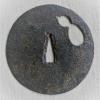
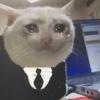






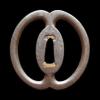

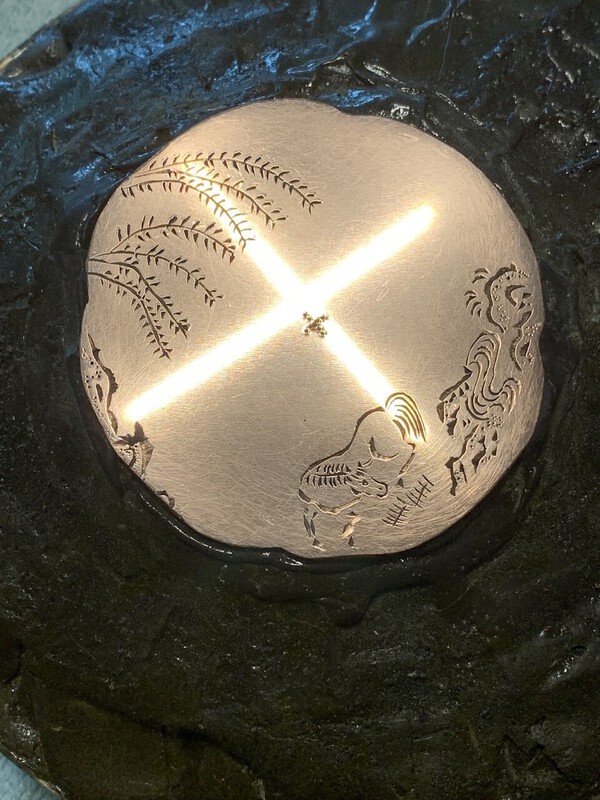
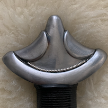
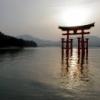
.thumb.png.4c5df79fec171b2dc4a23af38e280a4d.png)

